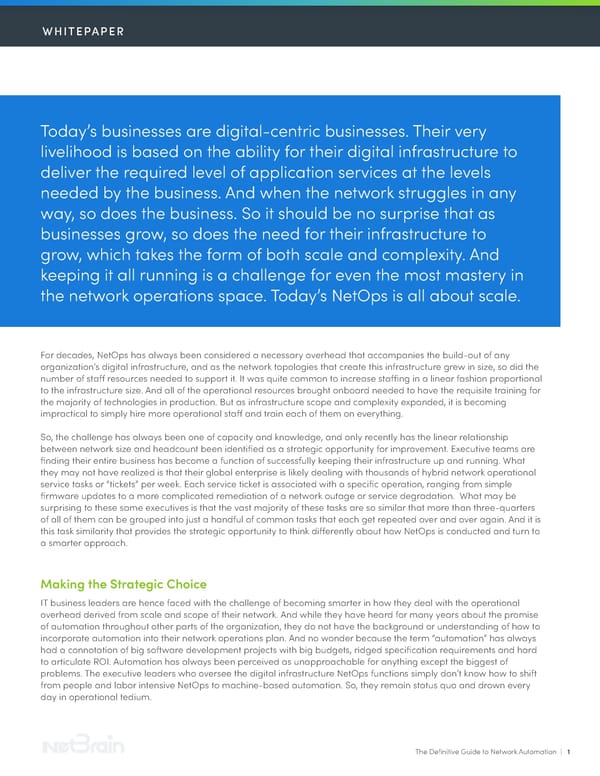WHITEPAPER Today’s businesses are digital-centric businesses. Their very livelihood is based on the ability for their digital infrastructure to deliver the required level of application services at the levels needed by the business. And when the network struggles in any way, so does the business. So it should be no surprise that as businesses grow, so does the need for their infrastructure to grow, which takes the form of both scale and complexity. And keeping it all running is a challenge for even the most mastery in the network operations space. Today’s NetOps is all about scale. For decades, NetOps has always been considered a necessary overhead that accompanies the build-out of any organization’s digital infrastructure, and as the network topologies that create this infrastructure grew in size, so did the number of staff resources needed to support it. It was quite common to increase staffing in a linear fashion proportional to the infrastructure size. And all of the operational resources brought onboard needed to have the requisite training for the majority of technologies in production. But as infrastructure scope and complexity expanded, it is becoming impractical to simply hire more operational staff and train each of them on everything. So, the challenge has always been one of capacity and knowledge, and only recently has the linear relationship between network size and headcount been identified as a strategic opportunity for improvement. Executive teams are finding their entire business has become a function of successfully keeping their infrastructure up and running. What they may not have realized is that their global enterprise is likely dealing with thousands of hybrid network operational service tasks or “tickets” per week. Each service ticket is associated with a specific operation, ranging from simple firmware updates to a more complicated remediation of a network outage or service degradation. What may be surprising to these same executives is that the vast majority of these tasks are so similar that more than three-quarters of all of them can be grouped into just a handful of common tasks that each get repeated over and over again. And it is this task similarity that provides the strategic opportunity to think differently about how NetOps is conducted and turn to a smarter approach. Making the Strategic Choice IT business leaders are hence faced with the challenge of becoming smarter in how they deal with the operational overhead derived from scale and scope of their network. And while they have heard for many years about the promise of automation throughout other parts of the organization, they do not have the background or understanding of how to incorporate automation into their network operations plan. And no wonder because the term “automation” has always had a connotation of big software development projects with big budgets, ridged specification requirements and hard to articulate ROI. Automation has always been perceived as unapproachable for anything except the biggest of problems. The executive leaders who oversee the digital infrastructure NetOps functions simply don’t know how to shift from people and labor intensive NetOps to machine-based automation. So, they remain status quo and drown every day in operational tedium. The Definitive Guide to Network Automation | 1
 The Definitive Guide To Network Automation Whitepaper 12-30-21Three Page 1 Page 3
The Definitive Guide To Network Automation Whitepaper 12-30-21Three Page 1 Page 3